
The Gelug is the newest of the four major schools of Tibetan Buddhism. It was founded by Je Tsongkhapa (1357–1419), a Tibetan philosopher, tantric yogi and lama and further expanded and developed by his disciples.
A tulku is a distinctive and significant aspect of Tibetan Buddhism, embodying the concept of enlightened beings taking corporeal forms to continue the lineage of specific teachings. The term "tulku" has its origins in the Tibetan word "sprul sku", which originally referred to an emperor or ruler taking human form on Earth, signifying a divine incarnation. Over time, this term evolved within Tibetan Buddhism to denote the corporeal existence of highly accomplished Buddhist masters whose purpose is to ensure the preservation and transmission of a particular lineage.

Thubten Yeshe (1935–1984) was a Tibetan lama who, while exiled in Nepal, co-founded Kopan Monastery (1969) and the Foundation for the Preservation of the Mahayana Tradition (1975). He followed the Gelug tradition, and was considered unconventional in his teaching style.
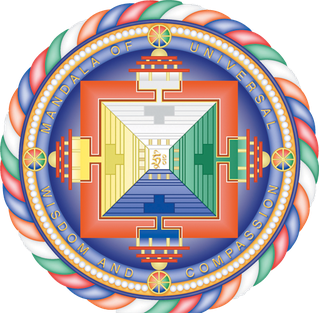
The Foundation for the Preservation of the Mahayana Tradition (FPMT) was founded in 1975 by Gelugpa Lamas Thubten Yeshe and Thubten Zopa Rinpoche, who began teaching Tibetan Buddhism to Western students in Nepal. The FPMT has grown to encompass over 138 dharma centers, projects, and services in 34 countries. Lama Yeshe led the organization until his death in 1984, followed by Lama Zopa until his death in 2023. The FPMT is now without a spiritual director; meetings on the organization's structure and future are planned.
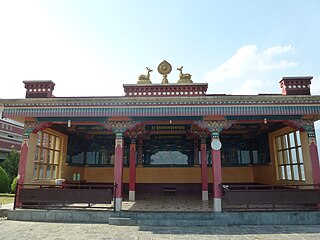
Kopan Monastery is a Tibetan Buddhist monastery near Boudhanath, on the outskirts of Kathmandu, Nepal. It is a member of the Foundation for the Preservation of the Mahayana Tradition (FPMT), an international network of Gelugpa dharma centers, and once served as its headquarters.
Phowa is a tantric practice found in both Hinduism and Buddhism. It may be described as "transference of consciousness at the time of death", "mindstream transference", "the practice of conscious dying", or "enlightenment without meditation". In Tibetan Buddhism phowa is one of the Six yogas of Naropa and also appears in many other lineages and systems of teaching.

Kyabje Dudjom Rinpoche Jigdral Yeshe Dorje was known simply as Dudjom Rinpoche. He is considered by many Tibetan Buddhists to be from an important Tulku lineage of Terton Dudul Dorje (1615–1672), and was recognized as the incarnation of Terton Dudjom Lingpa (1835–1904), a renowned treasure revealer. He was a direct incarnation of both Padmasambhava and Dudjom Lingpa. He was a Nyingma householder, a yogi, and a Vajrayana and Dzogchen master. According to his secretary Khenpo Tsewang Dongyal and many others, he was revered as "His Holiness" (Kyabje) and as a "Master of Masters".
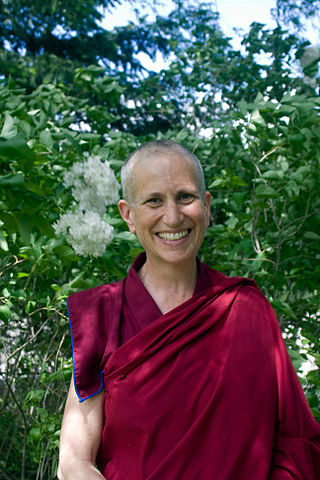
Thubten Chodron, born Cheryl Greene, is an American Tibetan Buddhist nun, author, teacher, and the founder and abbess of Sravasti Abbey, the only Tibetan Buddhist training monastery for Western nuns and monks in the United States. Chodron is a central figure in the reinstatement of the Bhikshuni ordination of women. She is a student of the 14th Dalai Lama, Tsenzhab Serkong Rinpoche, Lama Thubten Yeshe, Thubten Zopa Rinpoche, and other Tibetan masters. She has published many books on Buddhist philosophy and meditation, and is co-authoring with the Dalai Lama a multi-volume series of teachings on the Buddhist path, The Library of Wisdom and Compassion.
Thubten Gyatso is an Australian monk and was ordained by Lama Thubten Yeshe in the 1970s and was one of the first Westerners to become a monk in the Gelug school of Tibetan Buddhism. He is a Foundation for the Preservation of the Mahayana Tradition veteran who has been instrumental in establishing a number of Dharma centres in France, Taiwan, Australia, and Mongolia.
Thubten Shedrup Ling is the first Tibetan Buddhist monastery in Australia. It is located near Bendigo, Victoria, and is a member of the International Mahayana Institute of the Foundation for the Preservation of the Mahayana Tradition (FPMT).
Nicholas Ribush was among the first Westerners to be ordained as a monk in the Tibetan Buddhist tradition. A founder of Wisdom Publications, Ribush is today the director of the Lama Yeshe Wisdom Archive, a collection of thousands of teachings by Lama Yeshe and Lama Zopa Rinpoche, who pioneered the teaching of Tibetan Buddhism in the West.
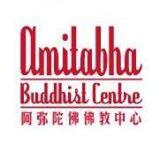
Amitabha Buddhist Centre is a Buddhist institution in Geylang, Singapore. It is affiliated with the Foundation for the Preservation of the Mahayana Tradition (FPMT), an international non-profit organisation, founded by Lama Thubten Yeshe.

Zong Rinpoche was a Gelug Lama and disciple of the third Trijang Rinpoche, junior tutor of the 14th Dalai Lama. He was famous as a sharp analyst and master of philosophical debate, as well as a Tantric practitioner. He was the Abbot of Ganden Shartse monastery.

Robina Courtin is a Buddhist nun in the Tibetan Buddhist Gelugpa tradition and lineage of Lama Thubten Yeshe and Lama Zopa Rinpoche. In 1996 she founded the Liberation Prison Project, which she ran until 2009.
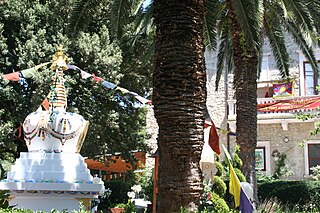
The Istituto Lama Tzong Khapa (ILTK) in Pomaia, a village in Tuscany, in Italy (40 km south of Pisa) is a branch of the Foundation for the Preservation of the Mahayana Tradition (FPMT), an international network of Gelugpa dharma centers. It is named for Tsongkhapa, founder of the Gelugpa monastic order of Tibetan Buddhism. The Dalai Lama has taught there on several occasions.
Manjushri Institute was a large Buddhist college situated at Conishead Priory in Cumbria, England from 1976 until its dissolution in 1991. In 1991 its assets, including Conishead Priory, were transferred to a new centre on the same premises, Manjushri Mahayana Buddhist Centre, which was later renamed Manjushri Kadampa Meditation Centre.

Geshe Lhundrup Rigsel was abbot of Kopan Monastery in Nepal. He was born in 1941 to a poor peasant family in Tibet, and joined Sera Monastery as a boy. In 1959 he fled from the Chinese invasion of Tibet and went to India. - In Buxa, a refugee camp in Northern India, he met Lama Thubten Yeshe and Lama Zopa. In the late sixties he journeyed to South India to start the clearing of land for the new Sera Monastic University. He received his Doctor of Divinity in Buddhist studies from Sera.
The Young Lamas Home School was a school established by the 14th Dalai Lama and Freda Bedi in 1960. Its funding was provided by Christopher Hills and its early abbot was Karma Thinley Rinpoche.

Khyongla Rato, pronounced "Chungla," was also known as Khyongla Rato Rinpoche, Rato Khyongla Rinpoche, Khyongla Rinpoche, Ngawang Lobsang Shedrub Tenpai Dronme, and Nawang Losang, his monk's name. Born in Dagyab county in Kham province in southeastern Tibet, he was recognized as an incarnate lama at an early age. He spent over 30 years receiving teachings and studying as a highly trained monk in the Tibetan Buddhist monasteries of Tibet. A respected scholar, he was a debate partner of the 14th Dalai Lama at his Geshe examination in Lhasa, Tibet. He founded the Tibet Center in New York City. The center co-sponsored many of the Dalai Lama's teachings in New York City.

Tushita is a centre for the study and practice of Buddhism from the Tibetan Mahayana tradition in Himachal Pradesh in northern India. It is located in the forested hills above the town of McLeod Ganj in village Dharamkot. The centre offers Introduction to Buddhism Courses and intermediate level courses for those who have already taken one of these introduction courses besides conducting Group Practice Retreats for practitioners of Tibetan Buddhism.













